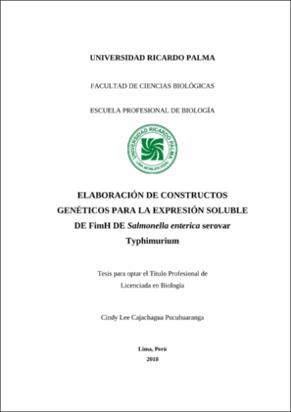“Elaboración de constructos genéticos para la expresión soluble de FimH de Salmonella enterica serovar Typhimurium.“
Fecha
2018-10-24Autor
Cajachagua Pucuhuaranga, Cindy Lee
Metadatos
Mostrar el registro completo del ítemResumen
Salmonella enterica serovar Typhimurium es una bacteria que frecuentemente produce infección en los seres humanos, siendo las aves y huevos infectados los principales vehículos de transmisión. Para lidiar con este problema es necesario el desarrollo de una vacuna eficiente para aves contra S. Typhimurium, el cual está relacionado con el conocimiento de la estructura tridimensional de todas las proteínas asociadas a la virulencia del patógeno, como FimH; una adhesina que permite la unión del patógeno a la célula huésped. El primer paso para resolver la estructura tridimensional de FimH de S. Typhimurium mediante cristalografía es la obtención de proteína soluble, por ello en el presente trabajo se realizó un análisis in silico de la secuencia protéica de FimH utilizando herramientas y programas bioinformáticos online con la finalidad de elaborar constructos genéticos de expresión in vitro que permitan obtener fragmentos proteicos de FimH solubles. Los resultados del análisis in silico postularon la idea de que FimH tiene dos dominios: un dominio de lectina (25-186aa) y un dominio de pilina (187-335aa), además se logró elaborar 3 constructos genéticos in vitro (pFimH25-335FL-DsF, pFimH187-335PD-DsF, pFimH25-186LD), el primer y segundo constructo (pFimH25-335FL-DsF, pFimH187-335PD-DsF) fueron de co-expresión y contenían las secuencias nucleotídicas de fimH25-335FL y fimH187-335PD respectivamente conjuntamente con la secuencia nucleotídica de dsF; y el tercer constructo (pFimH25-186LD) fue de expresión y contenía la secuencia nucleotídica de fimH25-186LD, las secuencias nucleotídicas de fimH25-335FL, fimH187-335PD y fimH25-186LD fueron confirmadas mediante secuenciamiento. Luego de los ensayos de expresión se determinó que todas las proteínas de interés (FimH25-335FL, FimH187-335PD y FimH25-186LD) se expresaban en las cepas BL21(DE3), TUNER, ARTIC y Rosetta, asimimo luego de los ensayos de solubilidad se logró obtener FimH25-186LD soluble en la cepa BL21(DE3).
Salmonella enterica serovar Typhimurium is a bacteria that frequently causes infection in humans, birds and eggs infected are the main transmission vehicles. To deal with this problem it is necessary to develop an efficient vaccine for birds against S. Typhimurium, which is related to the knowledge of the three-dimensional structure of all the proteins associated with the virulence of the pathogen, such as FimH; an adhesin that allows the union of the pathogen to the host cell. The first step to solve the three-dimensional structure of FimH of S. Typhimurium by crystallography is obtaining soluble protein, therefore in the present investigation an in silico analysis of the protein sequence of FimH was carried out using online bioinformatics tools and programs with the purpose to elaborate genetic constructs of expression in vitro that allow to obtain protein fragments of FimH soluble. The results of the in silico analysis postulated the idea that FimH has two domains: a lectin domain (25-186aa) and a pilin domain (187-335aa), besides, three genetic constructs in vitro were elaborated (pFimH25-335FL-DsF, pFimH187-335PD-DsF, pFimH25-186LD), the first and second constructs (pFimH25-335FL-DsF, pFimH187-335PD-DsF) were for co-expression and contained the nucleotide sequences of fimH25-335FL and fimH187-335PD respectively in conjunction with the nucleotide sequence of dsF; and the third construct (pFimH25-186LD) was for expression and contained the nucleotide sequence of fimH25-186LD, the nucleotide sequences of fimH25-335FL, fimH187-335PD and fimH25-186LD were confirmed by sequencing. After the expression assays it was determined that all the proteins of interest (FimH25-335FL, FimH187-335PD and FimH25-186LD) were able to express in strains BL21 (DE3), TUNER, ARTIC and Rosetta, similarly after to perform the solubility tests, soluble FimH25-186LD was obtained in strain BL21 (DE3).
Colecciones
- Biología [176]


